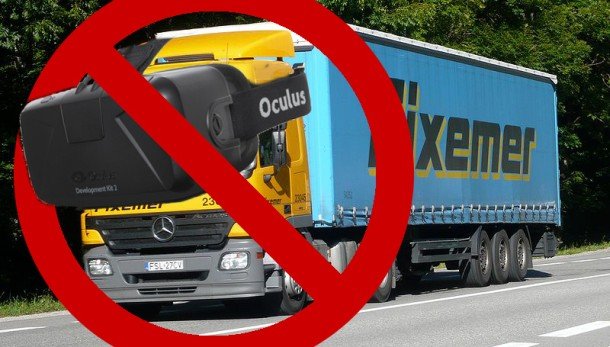Highlights from the Oculus Rift's Health and Safety guide

Virtual Reality is fun and cool and largely safe (probably). Our own Andy Kelly has been in and out of our office's Oculus Rift , and, other than some mild emotional trauma , he's pretty much fine.
As part of the new SDK , Oculus VR has updated the Rift's "Health and Safety Warning" documentation , and it's pretty great. There's something about the clash of new technology and old legislation that I find deeply amusing. As such, I'm going to highlight some of the highlights—not in an attempt to over-exaggerate the dangers of VR, but rather to celebrate sentences like, "symptoms of virtual reality exposure can persist and become more apparent hours after use."
Virtual reality exposure is a thing now. A thing with symptoms. That's pretty cool.
General Instructions and Precautions
Most of the document is filled by the now standard videogame warnings: be mindful of seizures, consult doctors, do not operate while submerged in the bath or during attempts to jam your toe in a plug socket. The usual. Things get interesting when the warnings have to address the unique elements of virtual reality.
"The headset produces an immersive virtual reality experience that distracts you from and completely blocks your view of your actual surroundings. Always be aware of your surroundings when using the headset and remain seated at all times. Take special care to ensure that you are not near other people, objects, stairs, balconies, windows, furniture, or other items that you can bump into or knock down when using—or immediately after using—the headset. Do not handle sharp or otherwise dangerous objects while using the headset."
That special VR room you constructed? The one lined by columns and columns of outwardly facing knives? You shouldn't have done that.
The biggest gaming news, reviews and hardware deals
Keep up to date with the most important stories and the best deals, as picked by the PC Gamer team.
Also, this: "Never wear the headset in situations that require attention, such as walking, bicycling, or driving." Er, it's not specified, but I assume they don't mean walking, bicycling, or driving in an Oculus-enabled game—else Euro Truck Simulator 2 has just been made an extreme sport.
Finally in this section, we learn that—like yoga or military withdrawal—virtual reality is something you do gradually:
"Ease into the use of the headset to allow your body to adjust; use for only a few minutes at a time at first, and only increase the amount of time using the headset gradually as you grow accustomed to virtual reality."
It's enough to make you wonder if somebody won't please think of the children. Actually, they did: "This product should not be used by children under the age of 7, as this is a critical period in visual development." That's a weird caveat at the end. Is the implication that by exposing little Timmy to, for example, Elite: Dangerous in VR, he's going to spend the rest of his life tripping space balls? Because I think that's a danger we all face.
Discomfort
This is the best section—if only to highlight how our bodies are rubbish and frail and we should all have our minds uploaded into indestructible robots. It starts with a worrying list of possible symptoms, including "involuntary movements", "disorientation", and "increased salivation". It's important to know why you're salivating, though: sure, maybe it's an impending sign of projectile voms, but maybe you're in a VR restaurant looking at a nice steak.
Then comes the terrifying prospect on virtual reality exposure:
"Just as with the symptoms people can experience after they disembark a cruise ship, symptoms of virtual reality exposure can persist and become more apparent hours after use. These post-use symptoms can include the symptoms above, as well as excessive drowsiness and decreased ability to multi-task. These symptoms may put you at an increased risk of injury when engaging in normal activities in the real world.
"Do not drive, operate machinery, or engage in other visually or physically demanding activities that have potentially serious consequences (i.e., activities in which experiencing any symptoms could lead to death, personal injury, or damage to property), or other activities that require unimpaired balance and hand-eye coordination (such as playing sports or riding a bicycle, etc.) until you have fully recovered from any symptoms."
I think what they're trying to say is that after I tried Half-Life 2 on the Rift for the first time, and then later stood at a train station, battling the cold grip of unbearable nausea, I was wrong to use the platform's vending machine.
Finally, this: "Be mindful of the type of content that you were using prior to the onset of any symptoms because you may be more prone to symptoms based upon the content being used." That's gotta be referring to the sex stuff , right?

Phil has been writing for PC Gamer for nearly a decade, starting out as a freelance writer covering everything from free games to MMOs. He eventually joined full-time as a news writer, before moving to the magazine to review immersive sims, RPGs and Hitman games. Now he leads PC Gamer's UK team, but still sometimes finds the time to write about his ongoing obsessions with Destiny 2, GTA Online and Apex Legends. When he's not levelling up battle passes, he's checking out the latest tactics game or dipping back into Guild Wars 2. He's largely responsible for the whole Tub Geralt thing, but still isn't sorry.

